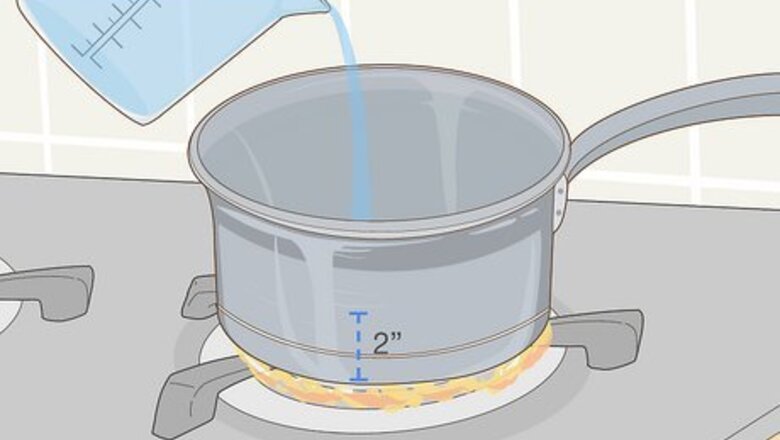
views
- Pasteurize liquids (like milk or cider) in a double boiler. Heat the liquid so it stays at 162 °F (72 °C) for 15 seconds, or 150 °F (66 °C) for 30 minutes.
- Pasteurize milk over direct heat by heating it on the stovetop until it reaches 149 to 167 °F (65 to 75 °C). Then, transfer it immediately to a sterilized container.
- To sterilize containers for pasteurized liquids, boil them on the stove for 10 minutes.
Using a Double Boiler
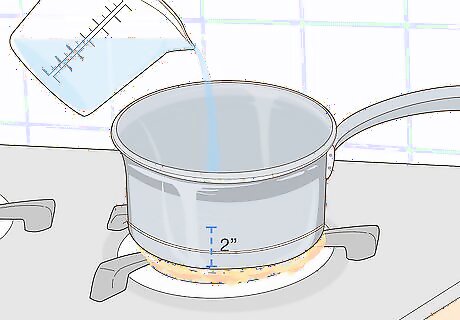
Pour in about 2 in (5.1 cm) of water in the bottom pan. Set up a double boiler on your stove. Add enough water to the bottom pan to fill it about 50% of the way full. A double boiler is a special set of pans that neatly nest on a stovetop burner. Using a double boiler prevents ingredients from getting scorched. If you don’t have a double boiler, use a large stockpot and a small saucepan, metal bowl, or thick glass bowl. The smaller dish must be small enough to rest on the top of the larger stockpot without the bottom of it sitting in the water.

Add the liquid you're pasteurizing to the top pan of the double boiler. Place the smaller pan on top of the bottom one and pour the liquid you're pasteurizing into it. Leave at least 1 to 2 in (2.5 to 5.1 cm) of empty headspace at the top of the dish to reduce the risk of overflow. The double boiler method is effective for pasteurizing milk, juice, and cider.
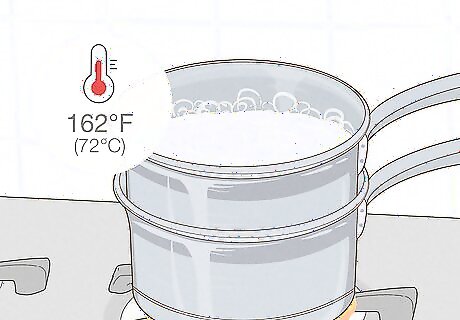
Bring the water to a boil as you stir the liquid you're pasteurizing. Use a spoon to stir the contents in the top of your double boiler over the boiling water. This reduces the risk of the liquid getting too hot, burning, or curdling. If any skin forms while the liquid heats, remove it with a ladle or spoon.

Heat the liquid you're pasteurizing at 162 °F (72 °C) for 15 seconds. Check the liquid’s temperature by inserting a thermometer into it. Be sure to only insert the tip of the thermometer about two-thirds deep into the liquid—don’t rest it on the bottom or sides of the dish. Alternative: Pasteurize the food or liquid at 150 °F (66 °C) for 30 minutes as an alternative. While this option takes longer, there's a lower chance of cooking the food or liquid. Insert a thermometer into the liquid so it's submerged about two-thirds deep and doesn't touch the bottom or sides of the double boiler. Make sure the temperature never drops below 150 °F (66 °C) for at least 30 minutes.
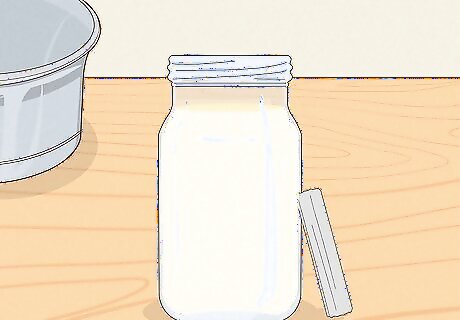
Transfer the saucepan to a cold water bath to cool it down. The easiest way to do this is to set it in your sink and fill it up with cold water. Add a tray of ice cubes to the water to cool the pan down even quicker. Allow it to sit in the cold water until the liquid is 68 °F (20 °C) or cooler. You can also use a large basin, bowl, or pot for this step.
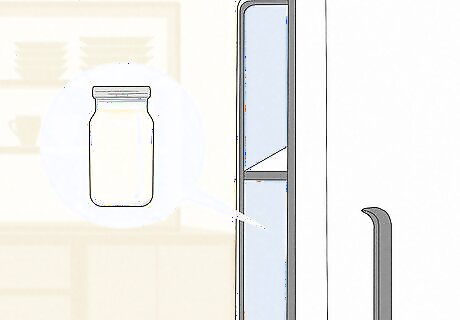
Pour the cooled food or liquid into your sterilized containers. Leave 2 in (5.1 cm) of empty headspace at the top of each jar. After filling the jars, cover them with an appropriate lid. You may wish to use a funnel or ladle to minimize accidental spills.
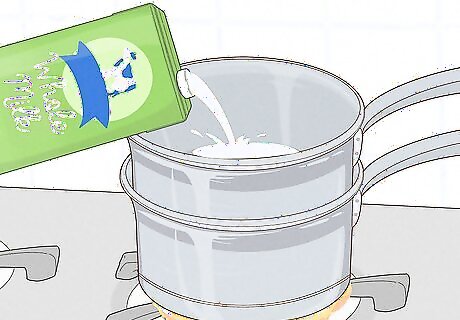
Store the pasteurized items in your refrigerator. Keep pasteurized liquids in the fridge until you are ready to use them. Pasteurized milk can last for up to 2 weeks. Pasteurized juice/cider, on the other hand, is only good for around 1 week in the refrigerator. The food or liquid should cool to a temperature below 40 °F (4 °C) within the first 6 hours.
Using Direct Heat
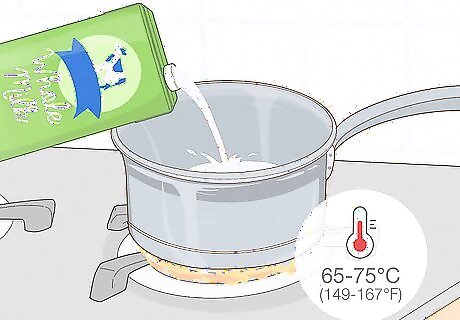
Heat the liquid on the stove until it reaches 65 to 75 °C (149 to 167 °F). Pour the liquid into a saucepan and turn on the heat. Stir the liquid constantly and stick a thermometer into the fluid to see how warm it’s getting. Once the liquid hits 65 to 75 °C (149 to 167 °F), transfer it to a sterilized container. Aim to drink the pasteurized milk within 2 weeks (or in 1 week. Or, drink it in 1 week if you’re pasteurizing cider). Note: The double boiler method is the standard, most widely-accepted method for at-home pasteurization. In one specific study, the direct heat method was proven effective in pasteurizing milk, but it wasn’t tested on other fluids/foods—so, you’re better off using it for just milk.
How to Sterilize Bottles/Containers
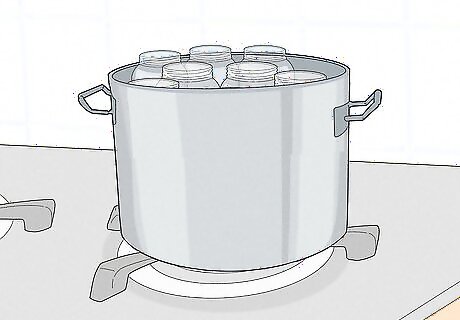
Place your glass containers in a large stockpot. Carefully arrange your containers and lids in a large stockpot to sterilize them. They should be able to stand upright without knocking into each other. Make sure that your pot is big enough to fit all your storage containers. While some people try to sterilize jars in a dishwasher, it doesn't guarantee sterilization the way that boiling containers does.

Fill the stockpot with water until it covers the jars by 2 to 3 in (5.1 to 7.6 cm). Put enough water into the stockpot to completely cover the storage containers so they are heated evenly. Set the stockpot on the stove once it is full. It’s best to arrange the containers inside of the stockpot before bringing the water to a boil. Glass tends to crack or otherwise break when exposed to rapid changes in temperature, so submerging the jars after the water has already reached a boil can be risky.

Boil the water for 10 minutes. Turn on your burner to high heat. Continue heating the water until it reaches a steady boil and then turn down the heat to keep the water at a low boil. Allow the containers and covers to stay submerged for 10 minutes after the water comes to a full boil. Boil for 1 extra minute for every 1,000 ft (300 m) you live above sea level. The containers may bump into each other a bit while being boiled. However, if the water is at a low boil, the containers should not hit each other enough to damage them.
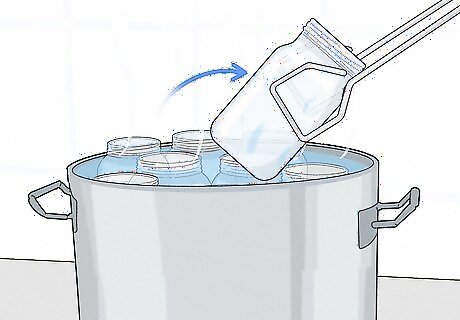
Remove the containers from the water with tongs or a jar lifter. Turn the burner off once the jars are sterilized. Then, carefully lift the containers and covers out of the hot water using tongs or a canning jar lifter. Use caution when removing the glass containers since they can still break easily at this stage.
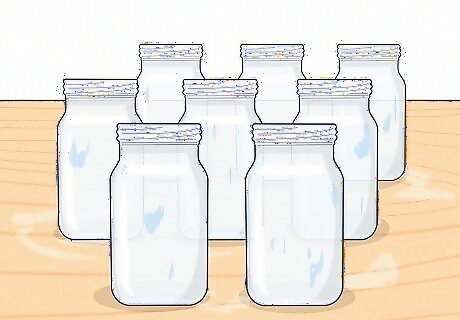
Let the containers dry on your counter. Do not place the containers in a refrigerator or freezer to speed the cooling process. Putting the containers in the refrigerator or freezer while they are hot could cause the glass to break. You do not need the containers to cool completely to room temperature. Slightly warm containers are less likely to break during pasteurization.












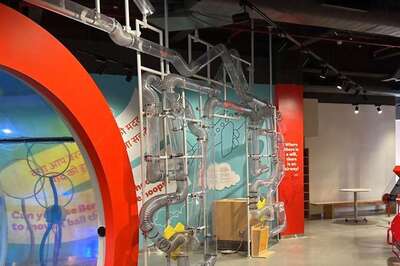


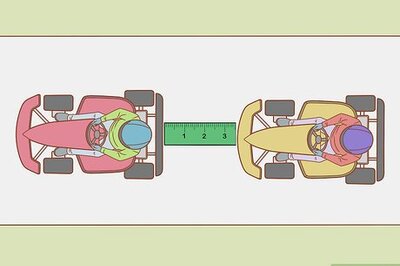



Comments
0 comment